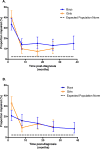Longitudinal analysis of quality-of-life outcomes in children during treatment for acute lymphoblastic leukemia: A report from the Children's Oncology Group AALL0932 trial
- PMID: 29112230
- PMCID: PMC5808870
- DOI: 10.1002/cncr.31085
Longitudinal analysis of quality-of-life outcomes in children during treatment for acute lymphoblastic leukemia: A report from the Children's Oncology Group AALL0932 trial
Abstract
Background: Children with average-risk acute lymphoblastic leukemia (AR-ALL) face many challenges that can adversely affect their quality of life (QOL). However, to the authors' knowledge, patterns and predictors of QOL impairment during therapy have not been well characterized to date.
Methods: Patients with AR-ALL who were enrolled on the Children's Oncology Group AALL0932 trial were offered participation in this prospective cohort study if they were aged ≥4 years at the time of diagnosis and had an English-speaking parent. At approximately 2 months, 8 months, 17 months, 26 months, and 38 months (boys only) after diagnosis, parents completed the Pediatric Quality of Life Inventory Generic Core Scales Version 4.0 (PedsQL4.0) and McMaster Family Assessment Device instruments for QOL (physical, emotional, and social functioning) and family functioning, respectively. The proportions of individuals scoring in the impaired range (2 standard deviations below the population mean) were calculated at each time point. Longitudinal impairment patterns and predictors were examined.
Results: A total of 594 participants with AR-ALL were diagnosed at a mean age of 6.0 years (standard deviation, 1.6 years). At 2 months, a substantial proportion of participants had impaired scores for physical (36.5%; 95% confidence interval [95% CI], 32.3%-40.8%) and emotional (26.2%; 95% CI, 22.5%-30.2%) functioning compared with population norms of 2.3%. These elevations persisted at 26 months. Emotional impairment at 2 months (odds ratio, 3.4; 95% CI, 1.5-7.7) was found to significantly predict emotional impairment at 26 months. In repeated measures analysis with multivariate modeling, unhealthy family functioning (odds ratio, 1.5; 95% CI, 1.1-2.1) significantly predicted emotional impairment controlling for age and sex. QOL outcomes were similar between sexes at the end of therapy (26 months for girls and 38 months for boys).
Conclusions: Many children with AR-ALL experience physical and emotional functioning impairment that begins early in treatment and persists. Early screening may identify high-risk patients who might benefit from family-based interventions. Cancer 2018;124:571-9. © 2017 American Cancer Society.
Keywords: acute lymphoblastic leukemia; emotional functioning; family functioning; health-related quality of life; pediatric.
© 2017 American Cancer Society.
Conflict of interest statement
A. Angiolillo, L. Balsamo, W. Carroll, M. Devidas, S. Hunger, N. Kadan-Lottick, M. Loh, X. Lu, E. Raetz, L. Sung, N. Winick, and D. Zheng report no conflicts of interest.
Figures



Similar articles
-
Prospective, longitudinal assessment of quality of life in children from diagnosis to 3 months off treatment for standard risk acute lymphoblastic leukemia: Results of Children's Oncology Group study AALL0331.Int J Cancer. 2016 Jan 15;138(2):332-9. doi: 10.1002/ijc.29708. Epub 2015 Sep 3. Int J Cancer. 2016. PMID: 26235006 Free PMC article. Clinical Trial.
-
Prevalence and predictors of anxiety and depression after completion of chemotherapy for childhood acute lymphoblastic leukemia: A prospective longitudinal study.Cancer. 2016 May 15;122(10):1608-17. doi: 10.1002/cncr.29946. Epub 2016 Mar 29. Cancer. 2016. PMID: 27028090 Free PMC article.
-
A prospective study of anxiety, depression, and behavioral changes in the first year after a diagnosis of childhood acute lymphoblastic leukemia: a report from the Children's Oncology Group.Cancer. 2014 May 1;120(9):1417-25. doi: 10.1002/cncr.28578. Epub 2014 Jan 28. Cancer. 2014. PMID: 24473774 Free PMC article. Clinical Trial.
-
A structured review of studies on health-related quality of life and economic evaluation in pediatric acute lymphoblastic leukemia.J Natl Cancer Inst Monogr. 2004;(33):102-25. doi: 10.1093/jncimonographs/lgh002. J Natl Cancer Inst Monogr. 2004. PMID: 15504922 Review.
-
Caregiver involvement in interventions for improving children's dietary intake and physical activity behaviors.Cochrane Database Syst Rev. 2020 Jan 5;1(1):CD012547. doi: 10.1002/14651858.CD012547.pub2. Cochrane Database Syst Rev. 2020. PMID: 31902132 Free PMC article.
Cited by
-
Comparison of Neurocognitive Functioning and Fine Motor Skills in Pediatric Cancer Survivors and Healthy Children.Cancers (Basel). 2022 Dec 3;14(23):5982. doi: 10.3390/cancers14235982. Cancers (Basel). 2022. PMID: 36497461 Free PMC article.
-
Bridging the gap in outpatient care: Can a daily patient-reported outcome measure help?Cancer Rep (Hoboken). 2022 Jan;5(1):e1421. doi: 10.1002/cnr2.1421. Epub 2021 Jul 10. Cancer Rep (Hoboken). 2022. PMID: 34245127 Free PMC article.
-
Prospective longitudinal evaluation of treatment-related toxicity and health-related quality of life during the first year of treatment for pediatric acute lymphoblastic leukemia.BMC Cancer. 2022 Sep 15;22(1):985. doi: 10.1186/s12885-022-10072-x. BMC Cancer. 2022. PMID: 36109702 Free PMC article.
-
Extracellular Vesicles and Cancer Therapy: Insights into the Role of Oxidative Stress.Antioxidants (Basel). 2022 Jun 17;11(6):1194. doi: 10.3390/antiox11061194. Antioxidants (Basel). 2022. PMID: 35740091 Free PMC article. Review.
-
Influence of social support on the social adaptive behaviors of children with acute leukemia in China: the mediating role of family functioning.BMC Pediatr. 2025 Jun 3;25(1):447. doi: 10.1186/s12887-025-05775-6. BMC Pediatr. 2025. PMID: 40457202 Free PMC article.
References
-
- Howlader N, Noone A, Krapcho M, et al. SEER Cancer Statistics Review, 1975–2010. [Based on the November 2012 SEER data submission, posted to the SEER web site, April 2013.] Bethesda, MD: National Cancer Institute; 2013.
-
- Sung L, Yanofsky R, Klaassen RJ, et al. Quality of life during active treatment for pediatric acute lymphoblastic leukemia. International Journal of Cancer. 2011;128:1213–1220. - PubMed
-
- van Litsenburg RR, Kunst A, Huisman J, Ket JC, Kaspers GJ, Gemke RJ. Health Status Utilities in Pediatrics A Systematic Review of Acute Lymphoblastic Leukemia. Medical Decision Making. 2013:0272989X13497263. - PubMed
-
- Pickard AS, Topfer L-A, Feeny DH. A structured review of studies on health-related quality of life and economic evaluation in pediatric acute lymphoblastic leukemia. Journal of the National Cancer Institute Monographs. 2004;2004:102–125. - PubMed
Publication types
MeSH terms
Grants and funding
LinkOut - more resources
Full Text Sources
Other Literature Sources
Research Materials

